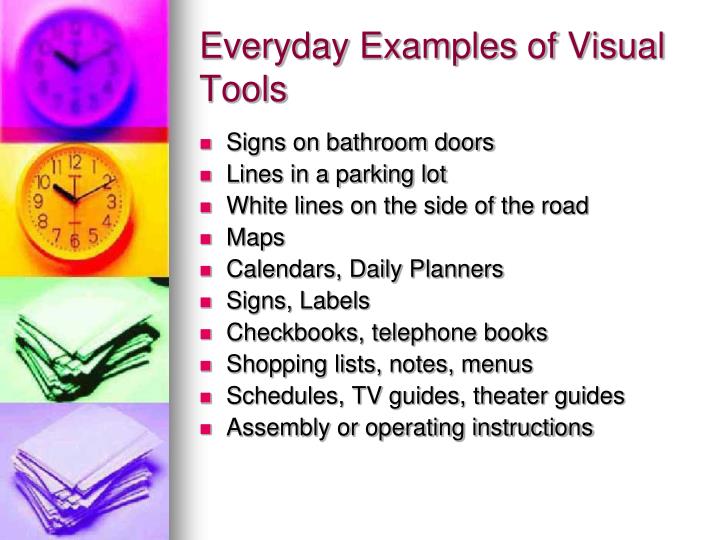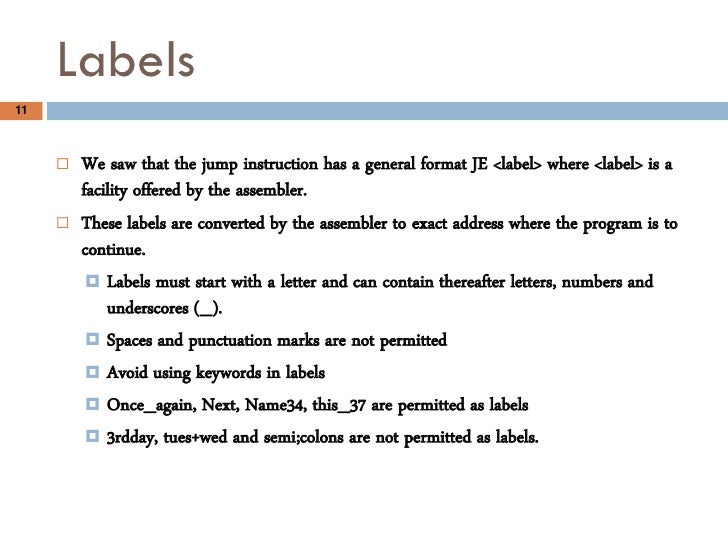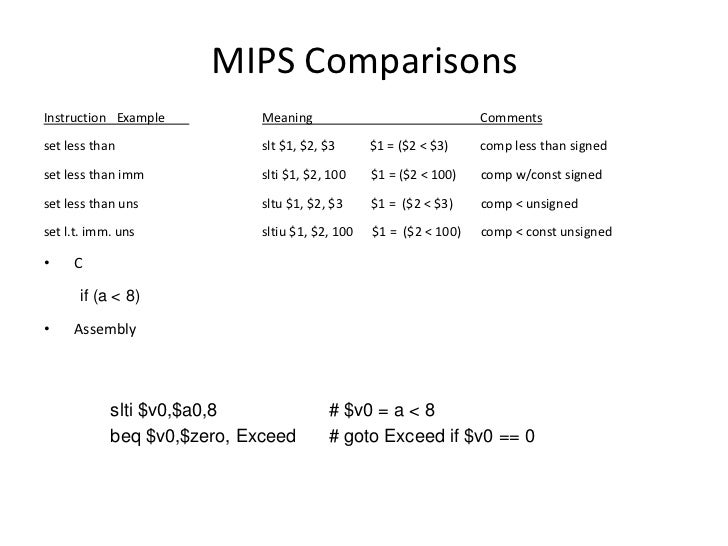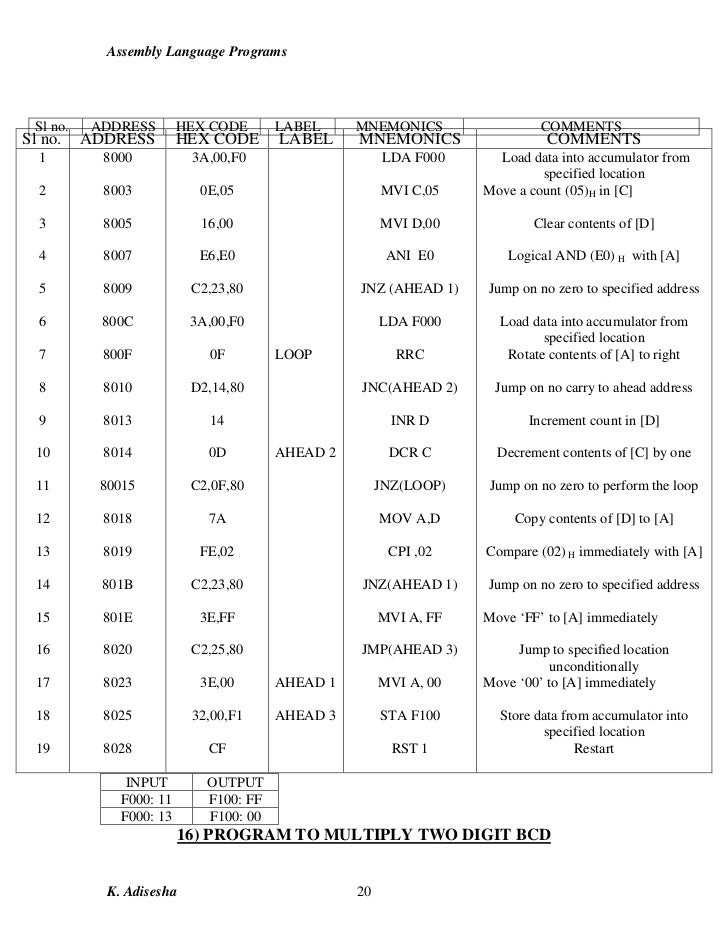41 labels in assembly language examples
PDF Computer Organization and Assembly Language • Directives have a syntax similar to assembly language but do not correspond to Intel processor instructions. • Directives are also case-insensitive: • Examples.data.code name PROC Instructions • An instruction in Assembly language consists of a name (or label), an instruction mnemonic, operands and a comment • The general form is: PDF Chapter 3 Assembly Language Fundamentals Assembly language instructions can have between zero and three operands, each of which can be a register, memory operand, constant expression, or I/O port. ... • constant expression: ex. 10 * 10 • register: ex. eax • memory (data label): ex. count Examples of assembly language instructions having varying numbers of operands • No ...
Assembly Language Syntax by Valvano Examples. Assembly Language Syntax Programs written in assembly language consist of a sequence of source statements. Each source statement consists of a sequence of ASCII characters ending with a carriage return. Each source statement may include up to four fields: a label, an operation (instruction mnemonic or assembler directive), an operand ...

Labels in assembly language examples
PDF Lecture 5 Basic Elements of Assembly Language Data Labels : a data label identifies the location of a variable, providing a convenient way to reference the variable in code. The following, for example, defines a variable named count: count DWORD 100 The assembler assigns a numeric address to each label. It is possible to define multiple data items following a label. pic microcontroller assembly language programming examples Opcode in pic microcontroller assembly language An opcode is short for 'Operation Code'. It is a number interpreted by your machine (uC) that represents the operation to perform. For example MOVLW is an Opcode. Labels A label is an identifier used to represent a line in code or section of a program. PDF Notes on assembly language macros - University of North Florida • An assembly language macro is a template whose format represents a pattern of 0 or more assembly language statements that might be common to multiple programs. • For this purpose, a macro language is used to provide a syntax for defining macros. • Where a sequence of assembly language statements can be represented by a macro, a macro ...
Labels in assembly language examples. Assembly language - Wikipedia Assembly language usually has one statement per machine instruction (1:1), but constants, comments, assembler directives, symbolic labels of, e.g., memory locations, registers, and macros are generally also supported. Assembly code is converted into executable machine code by a utility program referred to as an assembler. PDF Assembly Language: Overview - Princeton University Jump and Labels: While Loop! while (n>1) { } Checking if EDX is less than or equal to 1. 28 movl %edx, %eax andl $1, %eax je else jmp endif else: endif: ... • Read more assembly-language examples! • Chapter 3 of Bryant and OʼHallaron book! • Generate your own assembly-language code! • gcc217 -S -O2 code.c! PDF Assembly Language Programming - UTEP - Labels are symbols - Labels must begin in column 1. - A label can optionally be followed by a colon - The value of a label is the current value of the Location Counter (address within program) - A label on a line by itself is a valid statement - Labels used locally within a file must be unique. Adapted from notes from BYU ECE124 5 Learning Objectives - Min H. Kao Department of Electrical Engineering ... We will be using the riscv-g++ compiler and linking C++ files with assembly files. You will write the assembly files, and the C++ files help make the lab a little bit easier. Assembly Files. Assembly files end in a .S (capital S). The compiler includes all stages of compiling, assembling, and linking, but when we pass a file with a capital S ...
Jumping to Labels in Inline Assembly | Microsoft Docs Labels defined in __asm blocks are not case sensitive; both goto statements and assembly instructions can refer to those labels without regard to case. C and C++ labels are case sensitive only when used by goto statements. Assembly instructions can jump to a C or C++ label without regard to case. The following code shows all the permutations: C++ Compiler User Guide: Assembler labels - Keil Non-Confidential PDF versionARM DUI0375H ARM® Compiler v5.06 for µVision® armcc User GuideVersion 5Home > Language Extensions > Assembler labels 8.36 Assembler labels Assembly labels specify the assembly code name to use for a C symbol. For example, you might have assembly code and C code that uses the same symbol name, such as counter. What are Labels in assembly language? - Quora The label is in fact a shorthand for skipping the manual calculation of the number of bytes to add to or subtract from the index pointer, for jump to label means just setting the new place in the memory the execution should continue at, ip+ or - some value. Embedded Systems - Assembly Language - Tutorialspoint The names used for labels in assembly language programming consist of alphabetic letters in both uppercase and lowercase, number 0 through 9, and special characters such as question mark (?), period (.), at the rate @, underscore (_), and dollar ($). The first character should be in alphabetical character; it cannot be a number.
PDF Graded ARM assembly language Examples - AlanClements Anything starting in column 1 (in this case Stop) is a label that can be used to refer to that line. 4. The instruction Stop B Stop means 'Branch to the line labelled Stop' and is used to create an infinite loop. This is a convenient way of ending programs in simple examples like these. 5. PDF Chapter 2 HCS12 Assembly Language - TTU CAE Network A line of an assembly program Label field ... 2.1 Assembly language program structure 2.2 Arithmetic instructions 2.3 Branch and loop instructions ... Example: Write a program to add two 4-byte numbers that are stored at $1000-$1003 and $1004-$1007, and store the sum at $1010-$1013. Labels and Mainframe Assembler Macro Usage - SimoTime Macro with Branch & Labels The following examples will show how to use Macro Files that will generate code with Branch Instructions and unique labels. Branch with a Specified Label Using explicit names in the mainline code creates code that is simple and easy to understand. Example of Assembly The first part (LOOP in this example) is a label ; this is a word, invented by the programmer, which identifies this point in the program. It will be set equal ...
LC3 Assembly Language.ipynb - Bryn Mawr College The assembler first goes through the source code collecting labels, and their locations. During the second pass, it can substitute the used label in the operands with the label location minus instruction location - 1. .ORIG x4000 x4000 LD R1, SIX x4001 HALT x4002 SIX: .FILL #23 .END. So, the PC-offset for SIX is x4002 - x4000 - 1 = 1.
Assembly Language Instruction - an overview - ScienceDirect Labels must end with a colon. An example inline assembly program is given below: ... Others will be discussed as they are needed to execute an example program. Assembly language instructions have the form of initials or shortened (so-called mnemonics) words that represent microcomputer functions. These abbreviations are only for the convenience ...
What Is Assembly Language (With an Example) | Indeed.com In this example, "1:" is the label, which lets the computer know where to begin the operation. The "MOV" and "ADD" is the mnemonic command to move the number 3 into a part of the computer processor where it can function as a variable. "EAX," "EBX" and "ECX" are the variables. The first line of code loads 3 into the register "eax."
Assembly Language Style Guidelines - Instructions Since labels (i.e., identifiers) are the target of jump and call instructions, a typical assembly language program will have a large number of identifiers. ... to see abundant examples of poorly written assembly language code. Fortunately, with a little discipline it is possible to write readable assembly language programs. How you design your ...
Labels (x86 Assembly Language Reference Manual) A label can be placed at the beginning of a statement. During assembly, the label is assigned the current value of the active location counter and serves as an ...
Assembly Language Programming • ECEn 323: Computer Organization Assembly language is more readable than the binary machine code and is easier to edit and manipulate. The purpose of the "assembler" is to translate the text assembly language file written by a human into binary machine code executed by the processor (See section 2.12 in the textbook). This process is tedious and best left to a computer.
2 Assembly Language Programming - University of New Mexico In an assembly language program, a label is simply a name for an address. For example, given the declarations shown in Example 2.1, ``x'' is a name for the address of a memory location that was initialized to 23. On the SPARC an address is a 32-bit value. As such, labels are 32-bit values when they are used in assembly language programs.
Label (computer science) - Wikipedia In assembly language labels can be used anywhere an address can (for example, as the operand of a JMP or MOV instruction). Also in Pascal and its derived variations. Some languages, such as Fortran and BASIC, support numeric labels. Labels are also used to identify an entry point into a compiled sequence of statements (e.g., during debugging ).
8051 - "Label" in Assembly language - Stack Overflow Label is not bypassed. If you take a look at working of a loop then u will see that first DJNZ decrements the value of register then if the result is non zero it executes the label. In 1st example, starting from above: 1) A gets zero, then. 2) R2 gets 10, then. 3) A gets 25, then. 4) DJNZ decrements the value of R2 making it 9 and since the ...
Assembler User Guide: Labels - KEIL 7.6 Labels A label is a symbol that represents the memory address of an instruction or data. The address can be PC-relative, register-relative, or absolute. Labels are local to the source file unless you make them global using the EXPORT directive.
Learning Assembly Language | Codementor Labels. In assembly language, we use lots of labels. The usages of the labels translates into numbers in machine code and the labels disappear in the machine code. ... (really fast). For example, to the hardware, most registers are equivalent, even though the registers are partitioned or assigned particular uses by the software conventions ...
PDF Assembly Language Tutorial 60 00111100 +42 00101010 102 01100110 A negative binary value is expressed in two's complement notation. According to this rule, to convert a binary number to its negative value is to reverse its bit values and add 1. Example:
PDF Notes on assembly language macros - University of North Florida • An assembly language macro is a template whose format represents a pattern of 0 or more assembly language statements that might be common to multiple programs. • For this purpose, a macro language is used to provide a syntax for defining macros. • Where a sequence of assembly language statements can be represented by a macro, a macro ...
pic microcontroller assembly language programming examples Opcode in pic microcontroller assembly language An opcode is short for 'Operation Code'. It is a number interpreted by your machine (uC) that represents the operation to perform. For example MOVLW is an Opcode. Labels A label is an identifier used to represent a line in code or section of a program.
PDF Lecture 5 Basic Elements of Assembly Language Data Labels : a data label identifies the location of a variable, providing a convenient way to reference the variable in code. The following, for example, defines a variable named count: count DWORD 100 The assembler assigns a numeric address to each label. It is possible to define multiple data items following a label.














Post a Comment for "41 labels in assembly language examples"